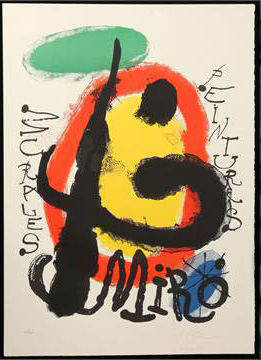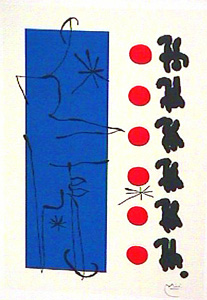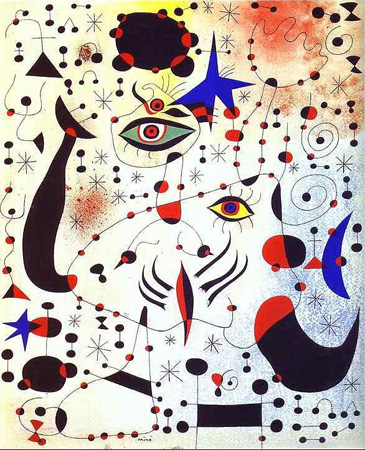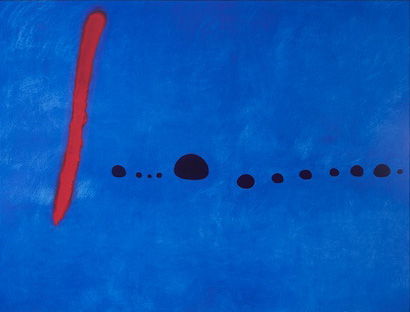Joan Miró by Erica Perry
 |
|
After
viewing the works of Miro and his peers in class and then going
even more in depth with Miro's works in research, I still do
not have a great understanding of the art world. I think that
all artists have a right to their views and should always be
able to paint how they feel. However, as I reviewed much of
the well-known works of Miro, I could not quite get into his
head. The works were beautiful, but I was not able to see their
true, all around beauty. Still, Miro was a wonderful addition
to the art world.
Joan
Miro was born April 20, 1983 in Barcelona, Spain. He studied
as a young student at the Barcelona School of Fine Arts
and the Academia Gali. He is recognized today as an all
inspiring Surrealist painter. Although through out his life,
he painted in many different styles. In the 1920s, he went to
Paris to paint and try to find his niche. January 24, 1937,
he had to set up shop in the gallery of his dealer. He was unable
to return to his homeland because of the Spanish Civil War.
|
| Miro's
works are very distinct because he allows his forms and designs
to jump out at the viewer. He uses large distinct, but manipulated
shapes. His use of bright colors allows for the paintings to draw
to it the eye of its viewer and keep it interested for extreme
lengths of time. Another aspect of Miro's works, are that they
are often so simple that one, myself included, might spend a lot
of their time viewing trying to find the meaning of the painting.
Once they think they have found the meaning, they take a some
more time to figure out the hidden meaning, if there is one. A
common aspect of Miro's paintings is that those viewing and admiring
his work look beyond the true meaning and make the painting more
complicated than it really is. Miro never thought of his paintings
as being abstract. He once said "Form for me is never
something abstract. It is always a token of something. For me,
form is never an end itself." Like so many other artists,
Miro never thought of his paintings as ever being truly finished.
Like during his Red and Black series of 1938, he painted
really only two different pieces. The other paintings were just
over laps of the first two in different perspectives. He also
would use red for one of the designs and black for the other.
Those were the only two colors used in this series of paintings.
Miro, although he only used two colors, and two of the most drab
colors, he made some terrific artwork. The paintings done in all
black gave a sense of unhappiness and in the second painting of
the series, discord and mass hysteria. However, when the paintings
are brought together and red is added, the art tells a whole new
story. The red gives the paintings a sort of uplifting look. The
situation does not look as bad or as unhappy. The addition of
the squiggly lines and shapes over, under, and around the painting
of the distinct characteristic shapes, adds more personality to
each of the designs. |
|
 |
| |
In
his early works, Miro painted more along the lines of actual
beings. Meaning people, buildings, landscapes, and everyday
events. During this time he used more of the earth tones and
some pastels. These works were absolutely beautiful and allowed
the viewer to be pulled inside to see deeper into the subject.
These paintings are the type of art that I am drawn to. These
works were all done before 1920, what I think is the time before
he truly found himself as an artist.
|
|
| |
|
His
later works are just as intriguing and magnificent, I just have
a harder time with absorbing all that they are. The works after
1920, are what he is most well known for. These works are "subject
matter drawn from the realm of memory and imaginative fantasy,"
according to Microsoft Encarta. I believe this to be a very
accurate description of these works. In these paintings, he
used a lot of distorted shapes and images. There were many curvy
lines and he liked to use dots and blobs of different shapes
and sizes. Many of these paintings are set on a neutral background,
allowing the bright colors to absorbed into the canvas and then
pushed back out into the eye of the viewer. His later works
did not tell a distinct story as much as they allowed each person
to create their own. If a person is having a happy, uplifting
day, the works will be bright, happy, and fun. However, in the
same way, if a person is having a horrible day, the paintings
will seem dark and gloomy. As I looked through the different
paintings of Miro, I could not help but see the wonderfulness
that they each encompassed. I am more than positive that Miro
did not intend for his works to be interpreted in the ways that
I did, but hey, art is about individuality.
|
 |
|
One
of my favorites of the Miro paintings, is Ciphers and Constellations
in Love with a Woman. This painting reminded me of those
clear summer nights when my friends and I would look up into the
sky and just marvel at the magnificent array of color, brightness
and endless space. This painting to me did not stop with the back
of the canvas. It continued on into the endless sky. The addition
of the light blue color that fades as it comes from the right
corner makes the painting just as enchanting as the clear summer
night sky. |
| Blue
II although it is so simple, it is one of his works that
allow for a person to stand and gaze and look for the meaning.
I personally do not think that Miro had a distinct meaning in
mind for this painting, but it is with all its simplicity nice
to look at. Milano and Animal Composition are two
of his ever so active pieces. They have multiple colors that just
seem to make the canvas glow. There are so many lines and shapes,
that one does not know where to start looking. It is works like
these that make Miro a master of the canvas. Other paintings that
are even more complicated, but also seem very fun are Carnival
of Harlequin and Dutch Interior I. Both of these paintings
are very active and have multiple subjects acting out at the same
time. It is to the benefit of the viewer that paintings do not
move. The setting for both of these works is indoors. |
|
 |
 |
|
The
Carnival of Harlequin describes the painting perfectly.
These two paintings made me think of the Cat in the Hat
by Dr. Seuss. This is only because of the unstopping activity
in all three. Miro's paintings were mostly of original creation
and mind. To be able to pull together non-distinct shapes and
images to almost make them distinct and to make the addition of
color and the context in which it is all perceived takes extreme
genius. I greatly admire Miro for his ability to look beyond what
is right in front of him and to reach a whole new level of reality.
His works of art and use of color help many of his paintings to
stand out. |
|
For
over seventy years, Miro blessed us with his artistic ability,
and I do believe that he helped many of the people who viewed
his work think beyond the real. It is a shame that he is no
longer around to share with us his ability first hand. However,
through study of his works and his ability, I do think it is
possible for him to live on in each one of us. Miro passed away
on December 25, 1983 in Majorca, Spain. I hope that the creation
of his works brought as much joy to him, as it does to all those
who have the privilege of taking the time to admire them.
|
Sites:
http://sunsite.dk/cgfa/miro/
www.ocaiw.com/miro.htm
www.moma.org/exhibitions/miro/menu.html
|